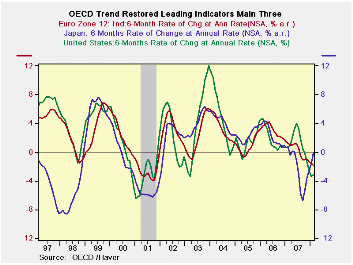 Global| Apr 11 2008
Global| Apr 11 2008OECD LEIs Show Continued Slowdown Signal
Summary
The OECD Leading indicators show weakness on a broad scale especially when viewed in their preferred habitat as six month percentage changes. On that basis, however, Japan is showing some more hopeful readings (increases!) even as [...]

The OECD Leading indicators show weakness on a broad scale
especially when viewed in their preferred habitat as six month
percentage changes. On that basis, however, Japan is showing some more
hopeful readings (increases!) even as Japanese authorities have engaged
in some scenario-shifting leading to downgrading.
The US shows the deepest six-month and three-month signal of
deterioration. OECD Europe at -1.8% is not as weak over six months but
it shows declines over the recent six month period as well as the
previous six month period unlike the US that is very weak in the
current six months but had showed expansion over the previous six month
period.
Neither the US nor Europe show the depth of decline in this
indicator that they did at the time of the last US recession. Japan did
touch that level of deterioration but only very briefing. It is now on
a sharp reversal course.
| OECD Trend-restored leading Indicators | ||||
|---|---|---|---|---|
| Growth progression-SAAR | ||||
| 3-Mos | 6-Mos | 12-mos | Yr-Ago | |
| OECD | 0.5% | -1.0% | -0.4% | 1.4% |
| OECD7 | -2.6% | -3.0% | -1.5% | 0.4% |
| OECD Europe | -2.4% | -1.8% | -1.2% | 1.7% |
| OECD Japan | 4.5% | 3.1% | -2.2% | 0.7% |
| OECD US | -4.2% | -4.8% | -1.2% | 0.0% |
| Six month readings at 6-Mo Intervals: | ||||
| Recent six | 6-Mo Ago | 12-Mo Ago | 18-Mo Ago | |
| OECD | -1.0% | 0.2% | 2.3% | 0.6% |
| OECD7 | -3.0% | 0.0% | 1.1% | -0.4% |
| OECD Europe | -1.8% | -0.7% | 1.2% | 2.3% |
| OECD Japan | 3.1% | -7.1% | 0.9% | 0.4% |
| OECD US | -4.8% | 2.6% | 1.4% | -1.4% |
| Slowdowns indicated by BOLD RED | ||||
Robert Brusca
AuthorMore in Author Profile »Robert A. Brusca is Chief Economist of Fact and Opinion Economics, a consulting firm he founded in Manhattan. He has been an economist on Wall Street for over 25 years. He has visited central banking and large institutional clients in over 30 countries in his career as an economist. Mr. Brusca was a Divisional Research Chief at the Federal Reserve Bank of NY (Chief of the International Financial markets Division), a Fed Watcher at Irving Trust and Chief Economist at Nikko Securities International. He is widely quoted and appears in various media. Mr. Brusca holds an MA and Ph.D. in economics from Michigan State University and a BA in Economics from the University of Michigan. His research pursues his strong interests in non aligned policy economics as well as international economics. FAO Economics’ research targets investors to assist them in making better investment decisions in stocks, bonds and in a variety of international assets. The company does not manage money and has no conflicts in giving economic advice.






